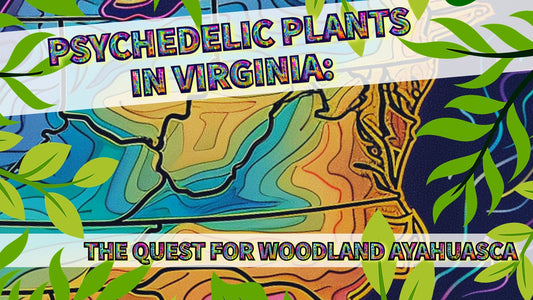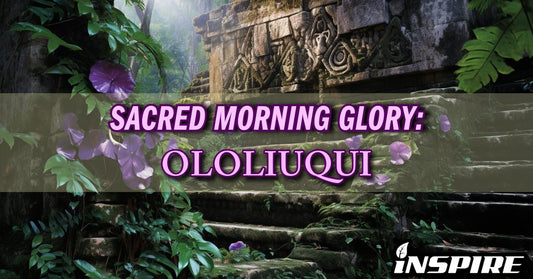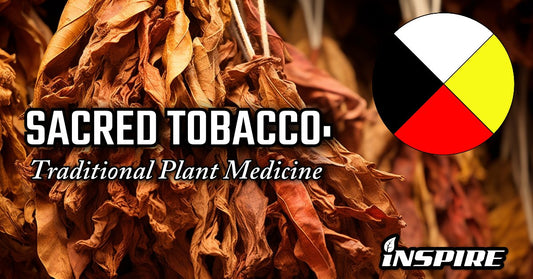Written By: Zach Champ
Connect with me on LinkedIn & Instagram!

Magic exists, and plants are the gateway to unlocking this realization!
The spirit of plants is consciousness, and plants impart their consciousness onto us when we consume them. This is why as natives we refer to these sacred plants as ‘teachers’, for they instruct us and educate us on the meaning of life and how to live it successfully and happily.
Every time we consume sacred psychedelic plants, the experiences we undergo are meant to be transformative, and enlightening…
When exploring these inner spaces of mind and outer spaces of the cosmos, our goals and intention should not be based in pleasure-seeking or hedonistic tendencies, but rather to ultimately gain a better sense of ourselves and our role and purpose as living beings.
Psychedelic plants are not recreational drugs in the sense that they make us “feel good”.
Quite the contrary, most profound psychedelic trips can be quite terrifying and discomforting for individuals.
So why torture ourselves this way? Because as one wise person once stated:

“The Cave You Fear to Enter, Holds the Treasure You Seek!”
It is no secret that psychedelic drugs are a catalyst for sparking self-awareness and consciousness.
In fact, some scientists and researchers now believe that the evolution of the human species was spurred by early hominids consuming and tripping on psychedelic plants...
This practice of consuming psychedelic plants has evolved to become an essential and key aspect of the human experience and plays an important process in our lives.

Art by Alex Gray
Since time immemorial, we as humans have reserved and set aside specific knowledge about the nature and meaning of life, only to be revealed to us as we grow older and mature at important and culminating moments of life.
Such moments include the passage from childhood into adulthood, the birth of one's own children, the coming of old age, and so on.
This graduated introduction and illumination into the different stages of life and the preparation for each stage is known as ‘the mysteries’ and every civilization going back to the beginning of the human race has had them.
In Native American culture they refer to these groups as ‘Medicine Societies’ and it is a great privilege and honor to be initiated into their secrets.

The mysteries play an important socio-religious and cultural role within society and help shape and develop people so they can play their part in the greater work that is civilization!
While each civilization’s mystery cults are different, they are at the core the same tradition and practice.
One of the key features of mystery cults and medicine societies is the use of psychedelic plants to facilitate the psychedelic and mystical experience that is key to the transformative apotheosis of participating in a mystery!
Examples of this include the Soma of Vedic India, the Kykeon of the Eleusinian mysteries of Ancient Greece, and the Peyote of the American southwest tribes.
Listed below is our collection of plants with their own mysteries and who which have been appreciated by our ancestors for their sacred properties for thousands of years…

MEXICAN DREAM HERB - Calea zacatechichi
Calea zacatechichi also known as MEXICAN DREAM HERB or BITTER-GRASS is a psychedelic member of the Asteraceae, or daisy family of plants. There are more than 100+ species and varieties of Calea. It is a small flowering shrub that is commonly found in Central and South America in both tropical and temperate environments.

Known to many indigenous groups within the area, Calea has hundreds of different names, depending on where and who you are speaking too. The Chontal Indians for instance refer to Calea as ‘THEPELAKANO’ or ‘leaves of the gods’ and it is epithets like this that give Calea its prestige and reputation.
Why? Because Calea zacatechichi is an oneirogen, or dreaming herb, whose bitter chemical alkaloids affect the lucidity and lifelike quality of one’s dreams. It is for these very reasons that Native American shamans would use the plant for divinatory purposes and to communicate directly with the spirit world.
Calea is also a medicinal plant that is commonly used for fighting off fevers and helping with digestion problems.

A typical dosage of Calea is usually around 1-5 grams of dried leaf which is either smoked or made into tea. Smoking or drinking Calea tea while awake can have a calming and lucid effect. When consumed prior to falling asleep, the tea can produce dramatic and intense dreams.
The dream states that Calea can induce are considered by many to be ‘more real than reality itself’. Those who consume Calea commonly report lifelike dreams with fantastical features such as talking to individuals who are not really there or flying around like superman.
Ironically, using Calea can also leave individuals restless and tired the next morning…

Why and how does this happen? Well it turns out that the active chemicals in the plant keep your brain in a near-awakened state of sleep called N1 versus the deep-sleep of REM which nourishes and refreshes us throughout the night. In this near-awakened form of sleep it is easier for individuals to dream for longer periods of time and with more intense dreams, but at the cost of getting a good night’s sleep!

SINICUICHI - Heima salicifolia
SINICUICHI known scientifically as Heima salicifolia is a shrubby flowering bush from the Lythraceae or loosestrife family of plants. It is native to North and Central America and can be found in habitats ranging from desert river basins to brush-lands.

Native Americans believe that the plant is sacred and have used it for medicinal and spiritual purposes for thousands of years. It is colloquially referred to as ‘SUN OPENER’ due to its psychedelic and spiritual properties.
Shamans associated the plant with the Aztec god of spring and desire, Xochipilli the ‘Prince of Flowers’.
Archeologists have found ancient cult statues of Xochipilli that are adorned with depictions of Sinicuichi’s flowers among other plants including morning glory and psilocybin mushrooms!

Sinicuichi is also widely appreciated for its medicinal anti-inflammatory properties and can be used in the treatment of diseases such as syphilis In traditional native herbal medicine remedies, Heima salicifolia is used to treat infertility and is believed to increase a woman’s chances of conception.
For ritualistic and shamanistic use, typically a fermented drink is brewed from fresh or dried leaves that are left to ferment in the sun for 24 hours. Indigenous peoples believe that soaking the plant in the Sun’s rays impart’s the sacred knowledge of the Sun into the plants brew.

The Sinicuichi experience is euphoric and energetic, individuals will feel a warm rush of bliss envelope their bodies and in larger doses it is not uncommon for distorted hearing and audio hallucinations to emerge.
Sinicuichi also affects memory and can allow you to recall past events with clarity and amazing detail! However, ironically and curious enough, repeated use of the plant can cause significant short-term memory loss. Scientists are still trying to understand this mechanism of the plant's ability to influence memory recall and retention.
Sinicuichi contains almost 20 different chemicals working together synergistically to produce it’s psychedelic effects. One of the main compounds, Cryogenine/Vertine is believed to responsible for the majority of the psychoactivity of the plant, but this is still being debated and researched. Cryogenine’s precursor compound Phenylamine is an alkaloid that is structurally similar to dopamine and adrenaline, which again provides more clues to how the plant influences the mind and body.

For advanced psychonauts and shamans, it is possible to create a crystalline extract from Sinicuichi that is more potent and can be smoked. The plant’s active chemical constituents are collected this way by using a simple hot-water extraction method.
Dried leaves are left to boil and simmer until the water completely evaporates and a residue or goo is left behind. It may take several runs to build up enough residue to form a small sticky ball. Smoking a little bit of this residue in combination with cannabis or another preferred smoking herb will result in a strong DMT-like visionary experience with shifting fractals and patterns.
This very same extract can also be used as a medicinal salve for the external treatment of wounds! In the jungles of central and South America indigenous peoples use the salve when thorns or sharp sticks accidentally stab or poke into the skin to keep them from getting infected.

MAGIC MINT - Salvia divinorum
Salvia divinorum is a hallucinogenic plant member of the mint family that is native to Central America, primarily in the Oaxaca region of Mexico. It’s a small perennial herbaceous plant that produces tiny white trumpet-like flowers and features green ovate leaves.

SALVIA is consumed by either smoking, chewing, or drinking a tea made out of the dried leaves.
The traditional method of consuming Salvia is by chewing several fresh picked or dried leaves and allowing the juices from the plant to absorb slowly through the gums and mouth. Rinsing your mouth out with baking soda or mouthwash prior to tripping can allow for better absorption of the Salvinorin A through the mucous membranes of the mouth, although this is debated by experts.
If smoking salvia, it is recommended that you use a heady bong with multiple percolators so that a large amount of the smoke can be ingested in a short time, therefore producing the best results.

The main chemical constituent of Salvia divinorum is a terpenoid known as Salvinorin A. Salvinorin A is unique from other psychedelic compounds in that it is not an alkaloid, lacking a nitrogen base. It is quickly metabolized in the human body, with a half-life of around 8 minutes, so proper effective dosages must be ingested in a short time. Due to this fast acting half-life, this also means that trips generally only last from 15 minutes to an hour at most.
The Mazateca Indians revered the plant as a sacred feminine spirit, and after the colonization of Mexico and the widespread adoption of Catholicism, cults formed around the plant this time referring to the spirit of the Salvia as the Virgin Mary.

Tradition states that the plant must be prepared for ritual use (grinding of leaves and seeds, brewing, etc) by a virgin in order to appease the spirit of the plant. Indigenous people's view and respect Mother Salvia as a healing and teaching plant.
Smoking salvia, whether it is dried leaf or extract, can produce a visionary change of consciousness for a temporary period of 15-30 minutes. For many this makes it a seemingly fun, recreational, and harmless ‘tripping’ experience… However, the reality is that Salvia is a very spiritual and sacred plant, and the visionary experiences associated with consuming Salvia are by no means ‘fun’ or ‘harmless’. This shits scary!

Art by SalviaDroid
Speaking from personal experience, there is a surreal pixelated quality to the visions of Salvia, almost as if reality is breaking down or distorting in front of your very eyes, photon by photon…
There is no ascent to this realm, rather you are just suddenly thrust into it almost as if you were falling into a hole or stepping through a door into a new dimension. One minute you are here in reality, the next minute you are in a color and pattern filled hyperspace teeming with characters and objects.
Respect Salvia for what it is, and don’t harass the Mother unless you genuinely seek her advice or comfort!

EASTERN WOODLANDS AYAHAUSCA:
PASSIONFLOWER (Passiflora incarnata) + PRAIRIE MIMOSA (Desmanthus illinoensis)
While everyone is familiar with the Ayahuasca brew of the Amazon jungle, few are privy to know that it is possible to create a similar visionary brew using native plants found in North America. This sacred mixture of plants, known tongue-in-cheek as ‘Prairie-Huasca’ is possible due to the inherent entheogenic powers of Passionflower and Bundleflower!

SACRED PASSIONFLOWER, also known as Maypop or by the native Algonquin word Mahcawq is a quick-growing perennial vine with a distinctive showy flower and small green fruit. When the Spanish first arrived in the New World and encountered the plant, they related the flower’s appearance to the symbolism of Jesus on the Christ hence the name ‘passionflower’.
PASSIONFLOWER plays an important role in the ecology of wildlife habitats, by attracting various types of pollinating insects and birds. The fruit is popularly used in various teas, juices, and as a flavoring in snacks and candy.
However, what few people know is that Passionflower is also medicinal and psychoactive!
Passiflora species have many natural properties that make them prized as ingredients for herbal medicines. Passionflower is a potent MAOI (Monoamine Oxidase Inhibitor), meaning that it can disable certain enzymes within the gut to make the absorption time and potency of other drugs more powerful. It can also increase GABA, a neurotransmitter responsible for calming nerve cells within the brain, especially during stress. Passionflower’s sedative properties make it perfect for use as a medicine to promote sleep and relaxation.

Desmanthus illinoensis known commonly as BUNDLEFLOWER, is a perennial shrub from the Fabaceae or bean family of plants that grows throughout North America. It is typically found in areas of disturbed soil such as the sides of rocky slopes, stream banks, or roadsides.

BUNDLEFLOWER is edible, medicinal, and psychoactive. Native Americans would use Bundleflower to process into a form of flour that was baked into fry breads and cookies. Interestingly enough, like other plants in the same Mimosa genus, the root bark contains DMT and NMT which makes it the principal ingredient for the Prairie-Huasca brew!
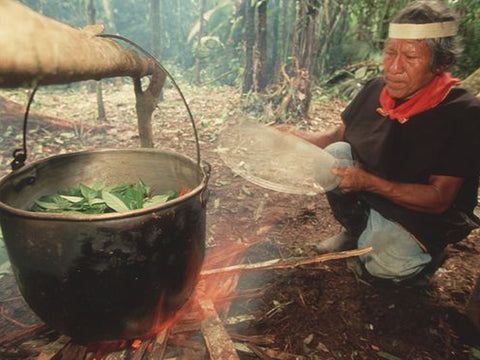
What is Ayahuasca?
Scientists have discovered that many plant species contain DMT. Indigenous peoples have known for thousands of years that when you combine these DMT-containing plant species with other plants that you can create a special brew which imparts fantastical and extraordinary mystical experiences. This brew is called Ayahuasca.
Pharmacodynamics Of Mixing Plants:
What happens when you combine psychoactive plants? The art of cooking Ayahuasca is a science that requires skill and knowledge in botany, chemistry, and the human body. Not understanding what you are doing can result in adverse reactions including illness and death.
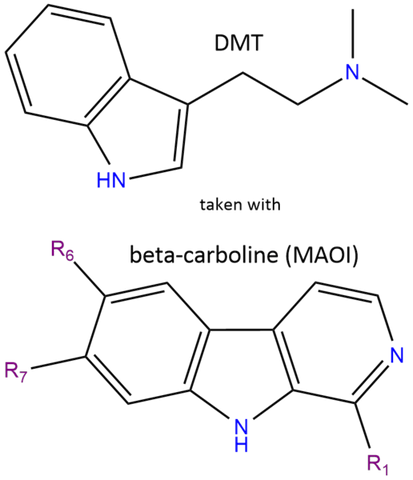
Just how exactly does Ayahuasca work? Harmine containing alkaloids found in Passionflower act as Monoamine Oxidase inhibitors and interact with the naturally occurring DMT and 5-MeO-DMT found in the Bundleflower to potentiate and create the visionary experience.
When ingested orally, DMT is not typically active unless combined with a Monoamine Oxidase Inhibitor (MAOI) which temporarily disables enzymes in the gut. When these enzymes are disabled, the DMT that is taken orally now becomes more bioavailable and therefore the effects of the trip are significantly increased. Without the use of Passionflower, the naturally occurring DMT found in the Bundleflower would be weak and barely active.

You should know that using plants in this manner is very risky. This knowledge was traditionally kept secret and only passed down to those who were being initiated into medicine societies where the plants were used for healing and performing ceremonial rites of magic.
This is not botanical or medicinal knowledge for the lay-person or profane!
Accidentally consuming too much of each plant can cause a medical condition known as Serotonin Syndrome or a so-called hypertensive crisis. Symptoms include increased heart rate, high blood pressure, throbbing headache, light sensitivity, incoherent speech, and eventually you will just seize out and go into a coma before dying. Don’t fuck up!

Why do we vomit on Ayahuasca brews and why does this help facilitate the shamanic experience?
Many people after consuming Ayahuasca will often find themselves throwing up and dry-heaving. This is a normal part of the tripping experience and is actually considered by shamans to be the plant spirits way of forcing the body to purge unwanted toxins before inducing the visionary aspects of the experience.
It’s important to have a trip sitter during these types of experiences because the risk of an individual becoming unconscious while vomiting and choking is very real.
If an individual ever starts vomiting bile or blood, seek medical attention immediately.

THORN APPLE / JIMSON WEED - Datura stramonium
Datura stramonium is one of the nine flowering, poisonous plant species found in the Solanaceae or nightshade family. The particular species of Datura that is native to North America and which we would be most familiar with is known as JIMSON WEED or THORN APPLE.
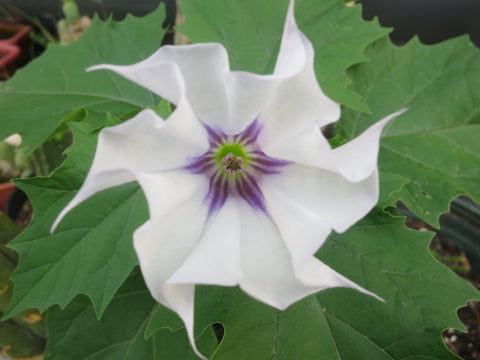
DATURA is widely known for its intoxicating effects which can include inducing delirium and panic attacks, and even causing death in high dosages. As part of traditional herbal medicine the leaves are either smoked, or the seeds are used for creating poisonous potions.
As a medicinal plant, it is useful for treating inflammation and hemorrhoids through use as a topical solution, typically with a poultice. In fact, over-the-counter creams used to treat hemorrhoids contain an active ingredient which is specifically derived from Datura and its related species.
In the 18th and 19th century it was a common practice to smoke a tiny amount of the leaves to treat the symptoms of asthma, although this is less popular today. Naturally occurring alkaloids in the plant such as Atropine act as a muscarinic antagonist with properties that can increase or decrease blood flow and mucus production in the lungs.

Datura contains plant-based tropane alkaloids such as Scopolamine and Atropine which are potent deliriants and anticholinergic drugs. Tropane alkaloids are known for being toxins and when ingested can have negative side-effects including increased heart-rate, hypothermia, and abnormal dilation of the eye’s pupils causing painful sensitivity to light.
Algonquin peoples would consume a mixture of Datura and other plants called Wyssocon which was used as an intoxicating brew for a coming of age initiation into adulthood. The Aztec believed that Datura was the 'sister' of Ololiuqui or sacred Morning Glories.
In South America, criminals will use Datura to create a powder used for mind control and inducing memory loss in people. These criminals will meet with unsuspecting tourists and locals and trick them at bars and restaurants with laced drinks before following the victim’s home and robbing them of all their possessions.
Haitian voodoo priests also would use Datura in combination with other plants to entrance and stupefy their victims and turn them into zombies, a practice which still occurs to this day.

In Europe and colonial puritan North America, it is believed Datura was a key ingredient for the concoction used by practicing witches to create so-called “Flying Witch Ointments” which would be applied to the mucous membranes of the vagina.
The secretive and sexual nature of this practice combined with the extreme strict puritanical beliefs of colonial American society caused many women to be executed for practicing black magic as part of the Salem Witch Trials. During this time it was even illegal for women to grow Datura in their gardens…
We strongly recommend that individuals DO NOT consume datura as it is a very dangerous and unpleasant drug.

Datura hallucinations can be lifelike and realistic, making the plant’s visionary experience very uncomfortable. Individuals who trip on datura commonly report seeing dead people, phantom objects that are not really there, or insects crawling on their skin.
The risk of death or illness with Datura is also very high as the plant has a small threshold between tolerable doses and lethal dosages.

KAVA KAVA - Piper Methysticum
Piper methysticum is a small shrub that grows on islands across the south Pacific. Known by its native name of KAVA KAVA (which means 'bitter' in the Tongan Polynesian language) it is a relative of the pepper family.

In Hawaii, Fiji, and Micronesia indigenous Polynesian people will create a ceremonial and recreational beverage from the root of the plant.

KAVA KAVA plays a role that is similar to alcohol because it is drunk primarily in social contexts and used as a social lubricant. For this reason, Kava Kava is popular as a substitute for alcohol and may help recovering alcoholics fight their addiction as a ‘safer’ option.

Just how exactly does Kava Kava work? Kavalactones found within the plant increase production of GABA In the brain and also act as MAOB inhibitors, producing a benzodiazepine like effect in the brain. The overall result is that Kava Kava is a plant with powerful sedative and narcotic tendencies.

SASSAFRAS- Sassafras albidum
SASSAFRAS is a flowering tree that features distinctive tri-lobed leaves and a characteristic aromatic root bark. It is native to North America and commonly grows along the under-stories of forests and the edges of fields where it prefers partial shade and partial sun.

Native Americans have used Sassafras for thousands of years. In the American south and in the Appalachian mountains Sassafras tea is a common traditional drink which is slightly psychedelic. The inner root bark of Sassafras is used as a flavoring for root beer and candy snacks. Roots and stems are typically boiled to produce the tea and flavoring.
Sassafras essential oil is anti-inflammatory and commonly used as a treatment for arthritis and joint pain. The essential oil is also an effective treatment for killing and removing head lice.

The unique aromatic flavor and taste of Sassafras is derived from its main chemical constituent- Safrole.
Sassafras contains high concentrations of Safrole which is also a precursor chemical for the production of MDMA and MDA, also known as “molly” and “sassy” respectively.
For this reason the DEA has made Safrole illegal to produce and sell in the United States.

MDMA and MDA are classified as empathogenic drugs, meaning they are pro-social in context and use.
Individuals frequently report that they are able to socialize and have more in-depth conversations while under the influence of MDMA and MDA.

Tripping on MDMA or MDA is referred to as “rolling” because of the consistent euphoric surge of warmth and energy users feel. Emotions come more easily and are much more manageable.
The ability to reason with and grasp uncomfortable topics and trauma is enhanced. It is for these very reasons that MDMA has been researched as a therapy drug for use in the treatment of depression and PTSD.

MORNING GLORY- Ipomoea purpurea
MORNING GLORIES are a creeping flowering vine featuring brilliant purple flowers and heart-shaped leaves that is native to North America, Mexico, and other parts of Central America.

Morning Glories can be found growing along the edge of forests and near rivers.
Like Sinnicuichi, Morning Glories are one of the plants found depicted on cult statues of the Aztec god Xochipilli, the ‘Prince of Flowers’.

The seeds of the Morning Glory flower contain the plant-based alkaloid LSA, also known as ergine. LSA is chemically similar to LSD and produces many of the same effects when consumed.
The onset of the drug usually happens 20-30 minutes after eating the seeds with a typical trip lasting anywhere from five to eight hours. Usually anywhere from 20 to 50 seeds are typically ground into a powder and added to a drink.

Coincidentally LSA is the same drug responsible for the psychoactive effects of the mystical Kykeon brew of the Eleusinian Mysteries of Ancient Greece and Rome. Ancient Aztec society used the plant's psychedelic properties in a similar manner with their secret religious medicine societies.
Initiates of these cults would consume a brew made from a mixture of the sacred plants together. The corresponding visionary experience would be the ‘mystery’ that is revealed to the initiate, illuminating them in the higher faculties and capacities of the mind, body, and soul.
(Warning: Do not eat raw morning glory seeds that are bought from stores, they are treated with insecticides and herbicides that will make you sick.)

YOPO- Anadenanthera peregrina
Anadenanthera peregrina, or YOPO is a perennial tree native to South America and the Caribbean. It closely resembles Acacia trees in its appearance and has horny, rough bark with strong, durable inner wood.

The seeds of the Yopo tree are full of various tryptamine based compounds that are responsible for its psychoactivity. While the seeds contain DMT, it is believed the primary chemical that is active when consuming Yopo is bufotenin, which is a tryptamine also commonly found in the Sonoran Desert Toad.
Humans have used Yopo for thousands of years. Some of the oldest archeological remains found in Argentina include a pipe made of cougar bone found with Yopo residue inside of it. Taino peoples in the West Indies and in Puerto Rico used Yopo as part of a religious ceremony called Cohoba, a practice which was introduced to them by indigenous peoples from South America.
Yopo is traditionally used as an hallucinogenic snuff that is prepared from beans found in the plant’s seed pods which are flattened and dried into a powder or paste.

This powder is then applied to a ritualistic bamboo or bone pipe made specifically for the ceremony called a Kuripe.
Once applied the pipe is stuck in the nose of the person designated to trip, and the shaman or trip sitter blows the powder directly into their nose.
This allows the material to be quickly absorbed into the mucous membranes of the nose and into the bloodstream, creating a fast acting and quick fading visionary experience that peaks around 20 minutes in and can last up to an hour before fading.

Indigenous people will sometimes combine the seeds of Yopo with the dried seeds of the Ayahuasca vine, or Banisteriopsis caapi plant, which acts as a MAOI and which enhances the visionary effects of the Yopo snuff. When a MAOI is added to the snuff in this way, they refer to the mix as Changa.
Tripping on Yopo is not for the faint of heart, and can include a variety of fantastical and sometimes fearful moments ranging from having in-depth conversations with incorporeal entities or spirits, to time traveling or perceiving a distorted sense of time, and experiencing overwhelming feelings of euphoria and spiritual excitement.
After the trip wears off, individuals are reportedly left with a lasting and calming sense of inner-peace that lasts several hours. Talk about a helluva roller coaster!

SAFETY & HARM REDUCTION
Every single one of the plants listed in this article is dangerous.
The same chemicals found in these plants that facilitate the psychedelic experience are still technically toxins and poisons which in sufficient quantities or combined with other drugs/plants can result in negative side-effects and even death!
You should use the utmost safety and caution when handling and consuming these sacred entheogenic substances.

There are several measures an individual can take prior to using psychedelic plants that can help them avoid bad tripping experiences, negative physical side-effects, and/or prevent them from harming themselves or others in confusion.
When trying a new plant or drug for the first time you should always microdose first before macro-dosing!
Many drugs have a fine threshold between their lethal dose and what may be considered an average or normal dose. You should also keep in mind that our bodies develop tolerance to drugs over repeated use, what may be a sufficient dose for one person may be too much for another.
Any time you use psychedelic substances you should have a trip-sitter.

A good trip sitter will be prepared for the worst, and should know basic first-aid and CPR. They should also have activated charcoal and water on hand in case the individual tripping needs to abort their trip or is having a negative reaction to the drugs. Activated charcoal can help slow the absorption of drugs in the body, and is a natural detoxifying ingredient. You should always keep water on hand in case of dehydration.
Many of the plants listed in this article are MAOI’s and can negatively interact with other prescription medications and even certain types of food. Whenever consuming MAOI’s you should avoid eating tyramine-containing foods. Tyramine is an amino acid that is commonly found in aged products like cheese, cured meats, beer, and ripened fruit.

MAOI’s are responsible for inhibiting monoamine oxidase which naturally breaks down tyramine in the body. When an individual consumes an MAOI they are unable to process and metabolize tyramine like normal, leading to excess levels of tyramine in the blood. Excess tyramine in the bloodstream can increase the risk of Serotonin Syndrome or hypertensive crisis.
There is a risk factor for developing psychosis after using psychedelic plants, especially with individuals who abuse the drugs and use them repeatedly and frequently. If you have a family history of mental illness or if your family has a genetic predisposition for schizophrenia, then you should also be cautious when using psychedelic and hallucinogenic substances as this can increase your chances of developing the disease.






